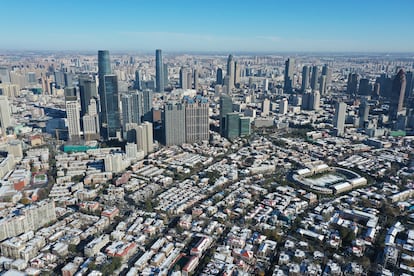China’s big cities are sinking
Groundwater extraction and heavy skyscrapers are key factors in an accelerating trend

All of the major Chinese cities are experiencing subsidence (sinking over time) to some extent. This process has been ongoing for years, with recent satellite data revealing an accelerated sinking rate of several millimeters to one centimeter per year. This sinking is attributed to both natural geological factors and human activities, particularly the excessive depletion of aquifers. The rapid urbanization in China in recent decades seems closely linked to the accelerated pace of subsidence in the region. Approximately 300 million urban Chinese are witnessing the ground sinking beneath their feet.
A few years back, a team of scientists highlighted numerous land subsidence events worldwide. Many were pinpointed in China’s densely populated regions. Recently, Chinese researchers used an advanced tool similar to LIDAR (Light Detection and Ranging) to monitor terrain-elevation changes in 82 cities with over two million residents. The InSAR (Interferometric Synthetic Aperture Radar) system on the European Space Agency’s Sentinel-1 satellite can detect minuscule altitude variations for each terrain pixel, equivalent to 40 x 40-meter surface grids. Since 2015, they’ve tracked changes using satellite data and recently published the study’s findings in Science.
The study found that 44.7% of large Chinese cities are sinking at a rate of at least three millimeters per year, affecting about 270 million urban residents. Additionally, 15.8% of the area is sinking even faster, with nearly 70 million people impacted by rates exceeding 10 mm/year. Some urban areas sink as much as 2.2 centimeters annually. Tianjin, with over 15 million residents, leads the list of the most heavily affected cities. The sinking cities are mainly in the eastern and southern parts of China, areas that have driven the country’s modernization in recent decades.
The accelerated sinking is caused by human activities, primarily the depletion of aquifers. When water is extracted faster than it can be replenished, empty spaces form underground, leading to land subsidence. The study linked the depletion rates of 1,619 Chinese aquifers to the extent of land subsidence in nearby cities. Another significant factor is the vertical expansion of new cities — tall, heavy buildings also contribute to subsidence. The study found that newer and taller buildings experience more sinking. Highways and heavy traffic also exert pressure on the ground, causing subsidence. In Beijing, areas near roads are sinking up to 45 millimeters annually. Practices like hydraulic fracking for hydrocarbon extraction and mining also impact land subsidence. In Pingdingshan, a coal-rich industrial city, the land is sinking by over 10 centimeters per year.
When an area sinks uniformly under infrastructure, there is no angular distortion. The problem is when subsidence is not uniform.Roberto Tomás, Alicante University (Spain)
“Venice is sinking at a rate of 1.6 millimeters a year,” said Roberto Tomás, a professor at Alicante University (Spain) and an expert in subsidence and civil engineering. “For comparison, Lorca and the Guadalentín valley were sinking 100 millimeters annually (now down to 80) due to groundwater extraction.” Aquifer exploitation in this part of Murcia, Spain, has led to the most severe case of subsidence in Europe. Tomás says a three-millimeter annual rate isn’t concerning, but 10 millimeters certainly is. “That’s a rate of one centimeter per year, 10 centimeters in a decade.” Tomás helped develop a global subsidence map showing its worldwide scope, and says it aligns with factors causing subsidence in Chinese cities: “Soft sediments, the sprawl of urban development, cities popping up out of nowhere with all the infrastructure, all the people and their water demands.”
Tomás, who is part of a UNESCO team on subsidence, highlights the significance of “differential settlement” — when one part of a structure’s foundation settles faster or more than another. He says we should pay closer attention to uneven soil sinking rather than just the total amount. “When an area sinks uniformly under infrastructure, there is no angular distortion. The problem is when subsidence is not uniform.” He offers two examples in Spain that he has studied extensively: Lorca and Murcia. Lorca sinks more than any other urban area in Europe, “but there is no damage to buildings because it’s a uniform subsidence.” The opposite happens in the city of Murcia. In the 1990s, he helped prepare a report identifying 150 buildings in Murcia with significant damage from uneven sinking that would cost €150 million ($163 million) to remedy.
Favorable geological environments like deltas and floodplains are abundant in China, and even more so in South Asia, Southeast Asia and East Asia.Robert J. Nicholls, Tyndall Center for Climate Change Research
Robert J. Nicholls is the director of the Tyndall Center for Climate Change Research, a partnership between the universities of East Anglia, Cardiff, Manchester, Newcastle and Fudan University in Shanghai. He argues that subsidence isn’t a worldwide issue in the strictest sense. “Subsidence only occurs where geological conditions allow. Favorable geological environments [for subsidence] like deltas and floodplains are abundant in China, and even more so in South Asia, Southeast Asia and East Asia. In these areas, urban pressure and groundwater extraction contribute to subsidence, among other causes,” he says.
The Science study predicts that China’s coastal cities will sink below sea level in the next 100 years. Over half of the 82 cities studied are located by the sea or just a few kilometers away. This presents a dual challenge: land subsidence and rising sea levels due to climate change. The outcomes hinge on actions taken to address both issues. To combat land subsidence, a highly effective method used in Murcia’s valleys since the 1970s was adopted by Osaka and Tokyo, cities that halted their sinking by replenishing more water than they extracted. Under worst-case climate scenarios and without mitigation efforts, a quarter of China’s coastal urban areas could resemble Venice and New Orleans by 2120.
Sign up for our weekly newsletter to get more English-language news coverage from EL PAÍS USA Edition
Tu suscripción se está usando en otro dispositivo
¿Quieres añadir otro usuario a tu suscripción?
Si continúas leyendo en este dispositivo, no se podrá leer en el otro.
FlechaTu suscripción se está usando en otro dispositivo y solo puedes acceder a EL PAÍS desde un dispositivo a la vez.
Si quieres compartir tu cuenta, cambia tu suscripción a la modalidad Premium, así podrás añadir otro usuario. Cada uno accederá con su propia cuenta de email, lo que os permitirá personalizar vuestra experiencia en EL PAÍS.
¿Tienes una suscripción de empresa? Accede aquí para contratar más cuentas.
En el caso de no saber quién está usando tu cuenta, te recomendamos cambiar tu contraseña aquí.
Si decides continuar compartiendo tu cuenta, este mensaje se mostrará en tu dispositivo y en el de la otra persona que está usando tu cuenta de forma indefinida, afectando a tu experiencia de lectura. Puedes consultar aquí los términos y condiciones de la suscripción digital.











































